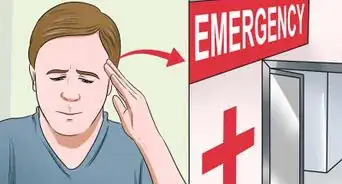This article was co-authored by Peter D'Aquino, L.Ac, MS, NCCAOM and by wikiHow staff writer, Megaera Lorenz, PhD. Peter D'Aquino is an Acupuncturist and Diplomate in Oriental Medicine based in New York City. Peter is licensed to practice in New York State and holds board certification by the National Certification Commission for Acupuncture (NCCAOM) and Oriental Medicine in acupuncture and Chinese herbal medicine. He has 10 years of experience practicing holistic pain management and sports medicine. He specializes in treating pain and orthopedic conditions along with rehab, fitness, weight loss, and digestive issues. He is also certified as a Personal Trainer by The National Academy of Sports Medicine (NASM) and certified in Functional Range Conditioning (FRC) and Functional Range Release (FRR) movement therapy. He holds an MA in Acupuncture and Herbal Medicine from Pacific College of Oriental Medicine in New York (PCOM).
There are 22 references cited in this article, which can be found at the bottom of the page.
wikiHow marks an article as reader-approved once it receives enough positive feedback. This article received 11 testimonials and 100% of readers who voted found it helpful, earning it our reader-approved status.
This article has been viewed 1,151,252 times.
Nausea is a horrible feeling. Luckily, if you’d rather not take medications to treat your upset stomach, there are several natural remedies that can help. From doing deep breathing exercises to drinking ginger tea, we’ll guide you through a few of the most tried and true methods for soothing nausea. If you have nausea along with other serious symptoms, like a high fever or severe stomach pain, call your doctor.
Steps
Expert Q&A
-
QuestionHow do I stop carsickness?
 Peter Gardner, MDPeter W. Gardner, MD is a board certified physician who has practiced Gastroenterology and Hepatology for over 30 years. He specializes in diseases of the digestive system and liver. Dr. Gardner earned his Bachelor’s degree from the University of North Carolina and attended Georgetown Medical School. He completed his residency in Internal Medicine and then his fellowship in Gastroenterology at the University of Connecticut. He is a previous Chief of Gastroenterology at Stamford Hospital and remains on the staff. He is also on the staff of Greenwich Hospital and New York (Columbia) Presbyterian Hospital. Dr. Gardner is an Approved Consultant in Internal Medicine and Gastroenterology with the American Board of Internal Medicine.
Peter Gardner, MDPeter W. Gardner, MD is a board certified physician who has practiced Gastroenterology and Hepatology for over 30 years. He specializes in diseases of the digestive system and liver. Dr. Gardner earned his Bachelor’s degree from the University of North Carolina and attended Georgetown Medical School. He completed his residency in Internal Medicine and then his fellowship in Gastroenterology at the University of Connecticut. He is a previous Chief of Gastroenterology at Stamford Hospital and remains on the staff. He is also on the staff of Greenwich Hospital and New York (Columbia) Presbyterian Hospital. Dr. Gardner is an Approved Consultant in Internal Medicine and Gastroenterology with the American Board of Internal Medicine.
Board Certified Gastroenterologist Ride in the front seat if you can and keep your eyes looking out ahead. If you're able to drive yourself, that can also help get rid of motion sickness.
Ride in the front seat if you can and keep your eyes looking out ahead. If you're able to drive yourself, that can also help get rid of motion sickness. -
QuestionWhich point in acupressure helps to relieve nausea?
 Peter D'Aquino, L.Ac, MS, NCCAOMPeter D'Aquino is an Acupuncturist and Diplomate in Oriental Medicine based in New York City. Peter is licensed to practice in New York State and holds board certification by the National Certification Commission for Acupuncture (NCCAOM) and Oriental Medicine in acupuncture and Chinese herbal medicine. He has 10 years of experience practicing holistic pain management and sports medicine. He specializes in treating pain and orthopedic conditions along with rehab, fitness, weight loss, and digestive issues. He is also certified as a Personal Trainer by The National Academy of Sports Medicine (NASM) and certified in Functional Range Conditioning (FRC) and Functional Range Release (FRR) movement therapy. He holds an MA in Acupuncture and Herbal Medicine from Pacific College of Oriental Medicine in New York (PCOM).
Peter D'Aquino, L.Ac, MS, NCCAOMPeter D'Aquino is an Acupuncturist and Diplomate in Oriental Medicine based in New York City. Peter is licensed to practice in New York State and holds board certification by the National Certification Commission for Acupuncture (NCCAOM) and Oriental Medicine in acupuncture and Chinese herbal medicine. He has 10 years of experience practicing holistic pain management and sports medicine. He specializes in treating pain and orthopedic conditions along with rehab, fitness, weight loss, and digestive issues. He is also certified as a Personal Trainer by The National Academy of Sports Medicine (NASM) and certified in Functional Range Conditioning (FRC) and Functional Range Release (FRR) movement therapy. He holds an MA in Acupuncture and Herbal Medicine from Pacific College of Oriental Medicine in New York (PCOM).
Licensed Acupuncturist The classic point in acupressure is Pericardium 6 or Nei Guan in Chinese. Studies have shown it can help with nausea. It is located on the inner side of the wrist, about three fingers width below the wrist crease. It is in the center of the wrist, between the two tendons. You can apply pressure on it for a few minutes.
The classic point in acupressure is Pericardium 6 or Nei Guan in Chinese. Studies have shown it can help with nausea. It is located on the inner side of the wrist, about three fingers width below the wrist crease. It is in the center of the wrist, between the two tendons. You can apply pressure on it for a few minutes. -
QuestionWhat is ST - 36 point in acupressure?
 Peter D'Aquino, L.Ac, MS, NCCAOMPeter D'Aquino is an Acupuncturist and Diplomate in Oriental Medicine based in New York City. Peter is licensed to practice in New York State and holds board certification by the National Certification Commission for Acupuncture (NCCAOM) and Oriental Medicine in acupuncture and Chinese herbal medicine. He has 10 years of experience practicing holistic pain management and sports medicine. He specializes in treating pain and orthopedic conditions along with rehab, fitness, weight loss, and digestive issues. He is also certified as a Personal Trainer by The National Academy of Sports Medicine (NASM) and certified in Functional Range Conditioning (FRC) and Functional Range Release (FRR) movement therapy. He holds an MA in Acupuncture and Herbal Medicine from Pacific College of Oriental Medicine in New York (PCOM).
Peter D'Aquino, L.Ac, MS, NCCAOMPeter D'Aquino is an Acupuncturist and Diplomate in Oriental Medicine based in New York City. Peter is licensed to practice in New York State and holds board certification by the National Certification Commission for Acupuncture (NCCAOM) and Oriental Medicine in acupuncture and Chinese herbal medicine. He has 10 years of experience practicing holistic pain management and sports medicine. He specializes in treating pain and orthopedic conditions along with rehab, fitness, weight loss, and digestive issues. He is also certified as a Personal Trainer by The National Academy of Sports Medicine (NASM) and certified in Functional Range Conditioning (FRC) and Functional Range Release (FRR) movement therapy. He holds an MA in Acupuncture and Herbal Medicine from Pacific College of Oriental Medicine in New York (PCOM).
Licensed Acupuncturist It is one of the well-known acupressure points, named Zu San Li in Chinese. It is about 4 finger breadths below the bottom of the patella or kneecap and one finger breadth lateral to the tibia bone. You can feel for a tender spot and apply direct pressure.
It is one of the well-known acupressure points, named Zu San Li in Chinese. It is about 4 finger breadths below the bottom of the patella or kneecap and one finger breadth lateral to the tibia bone. You can feel for a tender spot and apply direct pressure.
References
- ↑ https://www.nhs.uk/conditions/feeling-sick-nausea/
- ↑ Peter Gardner, MD. Board Certified Gastroenterologist. Expert Interview. 25 August 2020.
- ↑ https://www.albertahealthservices.ca/assets/info/cca/if-cca-managing-your-nausea-vomiting.pdf
- ↑ https://www.albertahealthservices.ca/assets/info/cca/if-cca-managing-your-nausea-vomiting.pdf
- ↑ https://www.uofmhealth.org/health-library/uf4437
- ↑ https://uvahealth.com/services/gastro/gerd
- ↑ https://www.ncbi.nlm.nih.gov/pmc/articles/PMC3154967/
- ↑ Peter D'Aquino, L.Ac, MS, NCCAOM. Licensed Acupuncturist. Expert Interview. 14 April 2020.
- ↑ https://www.mskcc.org/cancer-care/patient-education/acupressure-nausea-and-vomiting
- ↑ Peter D'Aquino, L.Ac, MS, NCCAOM. Licensed Acupuncturist. Expert Interview. 14 April 2020.
- ↑ https://www.insider.com/pressure-points-for-nausea
- ↑ Peter D'Aquino, L.Ac, MS, NCCAOM. Licensed Acupuncturist. Expert Interview. 14 April 2020.
- ↑ http://advance.uconn.edu/2002/020225/02022508.htm
- ↑ https://www.uofmhealth.org/health-library/uz2255
- ↑ https://www.nationwidechildrens.org/family-resources-education/family-resources-library/ease-nausea-with-natural-remedies
- ↑ https://www.albertahealthservices.ca/assets/info/cca/if-cca-managing-your-nausea-vomiting.pdf
- ↑ https://www.health.harvard.edu/blog/treating-stomach-bugs-best-solution-may-simplest-one-201606149799
- ↑ https://www.nhs.uk/conditions/feeling-sick-nausea/
- ↑ https://www.ncbi.nlm.nih.gov/pmc/articles/PMC5605819/
- ↑ https://www.ncbi.nlm.nih.gov/pmc/articles/PMC4818021/
- ↑ https://pubmed.ncbi.nlm.nih.gov/19250006/
- ↑ https://www.nationwidechildrens.org/family-resources-education/family-resources-library/ease-nausea-with-natural-remedies
- ↑ https://familydoctor.org/brat-diet-recovering-from-an-upset-stomach/
- ↑ https://wexnermedical.osu.edu/blog/the-nutrition-cheat-sheet-for-morning-sickness
- ↑ https://www.albertahealthservices.ca/assets/info/cca/if-cca-managing-your-nausea-vomiting.pdf
- ↑ https://www.nationwidechildrens.org/family-resources-education/family-resources-library/ease-nausea-with-natural-remedies
- ↑ https://www.albertahealthservices.ca/assets/info/cca/if-cca-managing-your-nausea-vomiting.pdf
- ↑ https://wexnermedical.osu.edu/blog/the-nutrition-cheat-sheet-for-morning-sickness
- ↑ https://www.nationwidechildrens.org/family-resources-education/family-resources-library/ease-nausea-with-natural-remedies
- ↑ https://www.albertahealthservices.ca/assets/info/cca/if-cca-managing-your-nausea-vomiting.pdf
- ↑ https://goaskalice.columbia.edu/answered-questions/nausea-causes-and-treatments
- ↑ https://www.mayoclinic.org/diseases-conditions/cyclic-vomiting-syndrome/diagnosis-treatment/drc-20352167
- ↑ https://www.ncbi.nlm.nih.gov/pmc/articles/PMC5605819/
- ↑ https://www.nlm.nih.gov/medlineplus/ency/article/003117.htm
- ↑ https://www.mayoclinic.org/diseases-conditions/dehydration/symptoms-causes/syc-20354086
- ↑ https://www.albertahealthservices.ca/assets/info/cca/if-cca-managing-your-nausea-vomiting.pdf
- ↑ https://www.albertahealthservices.ca/assets/info/cca/if-cca-managing-your-nausea-vomiting.pdf
About This Article
A simple way to help get rid of nausea without medication is to drink room temperature water or warm herbal teas since dehydration can cause nausea. Try to take sips throughout the day instead of drinking an entire glass all at once, and make sure to avoid very cold or very hot drinks. Consider drinking some ginger tea, which has been used to treat nausea caused by pregnancy and chemotherapy for a long time. While ginger tea is safe for pregnant women, just be sure to let your obstetrician know you’re drinking it and to only have 1 to 2 cups a day. If you can’t stand the taste of ginger, you can either take a ginger supplement or drink peppermint tea instead because peppermint has also been used to help treat nausea. For more tips from our Medical co-author, like how to alter your diet to avoid feeling nauseous, read on!
-Step-1-Version-4.webp)

-Step-2-Version-4.webp)
-Step-3-Version-4.webp)
-Step-4-Version-4.webp)

-Step-5-Version-4.webp)
-Step-6-Version-3.webp)
-Step-7-Version-3.webp)
-Step-8-Version-3.webp)
-Step-9-Version-3.webp)
-Step-10-Version-3.webp)
-Step-11-Version-3.webp)
-Step-12-Version-2.webp)
-Step-13-Version-2.webp)
-Step-14-Version-2.webp)
-Step-15-Version-2.webp)




-Step-9-Version-5.webp)

























































Medical Disclaimer
The content of this article is not intended to be a substitute for professional medical advice, examination, diagnosis, or treatment. You should always contact your doctor or other qualified healthcare professional before starting, changing, or stopping any kind of health treatment.
Read More...